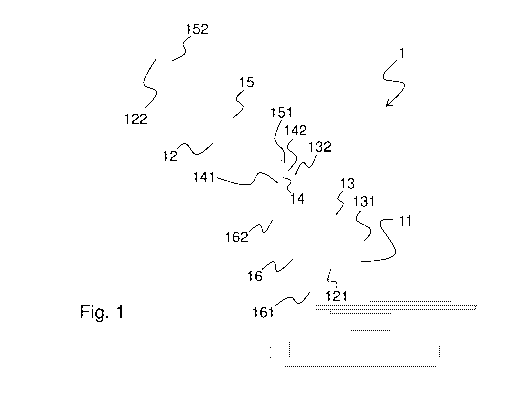Some of the information on this Web page has been provided by external sources. The Government of Canada is not responsible for the accuracy, reliability or currency of the information supplied by external sources. Users wishing to rely upon this information should consult directly with the source of the information. Content provided by external sources is not subject to official languages, privacy and accessibility requirements.
Any discrepancies in the text and image of the Claims and Abstract are due to differing posting times. Text of the Claims and Abstract are posted:
| (12) Patent Application: | (11) CA 3058094 |
|---|---|
| (54) English Title: | JIB ASSEMBLY |
| (54) French Title: | ENSEMBLE DE FLECHE |
| Status: | Deemed Abandoned and Beyond the Period of Reinstatement - Pending Response to Notice of Disregarded Communication |
| (51) International Patent Classification (IPC): |
|
|---|---|
| (72) Inventors : |
|
| (73) Owners : |
|
| (71) Applicants : |
|
| (74) Agent: | NORTON ROSE FULBRIGHT CANADA LLP/S.E.N.C.R.L., S.R.L. |
| (74) Associate agent: | |
| (45) Issued: | |
| (86) PCT Filing Date: | 2018-01-11 |
| (87) Open to Public Inspection: | 2018-08-02 |
| Availability of licence: | N/A |
| Dedicated to the Public: | N/A |
| (25) Language of filing: | English |
| Patent Cooperation Treaty (PCT): | Yes |
|---|---|
| (86) PCT Filing Number: | PCT/FI2018/050019 |
| (87) International Publication Number: | WO 2018138409 |
| (85) National Entry: | 2019-09-26 |
| (30) Application Priority Data: | ||||||
|---|---|---|---|---|---|---|
|
The disclosure relates to a jib assembly (1) comprising a support (11); a jib (12) attached pivotally to the support (11) for pivotal movement of the jib (12) in relation to the support (11) about a horizontal axis; a first linear hydraulic actuator (13) attached to the support (11) for regulating pivotal movement of the jib (12) and for maintaining the jib (12) in a specific position relative to the support (11); a lever arm (14) attached unrotatably to the jib (12); and a draw member (15) attached to the lever arm (14) and to the jib (12); wherein the first linear hydraulic actuator (13) is attached to the lever arm (14), and the lever arm (14) is arranged to extend in the direction above the jib (12).
L'invention concerne un ensemble de flèche (1) comprenant un support (11); une flèche (12) fixée pivotante au support (11) pour un mouvement de pivotement de la flèche (12) par rapport au support (11) autour d'un axe horizontal; un premier actionneur hydraulique linéaire (13) fixé au support (11) pour ajuster le mouvement de pivotement de la flèche (12) et pour maintenir la flèche (12) dans une position spécifique par rapport au support (11); un bras de levier (14) fixé de manière non rotative à la flèche (12); et un élément de traction (15) fixé au bras de levier (14) et à la flèche (12); le premier actionneur hydraulique linéaire (13) étant fixé au bras de levier (14), et le bras de levier (14) étant agencé pour s'étendre dans la direction au-dessus de la flèche (12).
Note: Claims are shown in the official language in which they were submitted.
Note: Descriptions are shown in the official language in which they were submitted.

2024-08-01:As part of the Next Generation Patents (NGP) transition, the Canadian Patents Database (CPD) now contains a more detailed Event History, which replicates the Event Log of our new back-office solution.
Please note that "Inactive:" events refers to events no longer in use in our new back-office solution.
For a clearer understanding of the status of the application/patent presented on this page, the site Disclaimer , as well as the definitions for Patent , Event History , Maintenance Fee and Payment History should be consulted.
| Description | Date |
|---|---|
| Application Not Reinstated by Deadline | 2024-04-24 |
| Inactive: Dead - RFE never made | 2024-04-24 |
| Letter Sent | 2024-01-11 |
| Deemed Abandoned - Failure to Respond to Maintenance Fee Notice | 2023-07-11 |
| Deemed Abandoned - Failure to Respond to a Request for Examination Notice | 2023-04-24 |
| Letter Sent | 2023-01-11 |
| Letter Sent | 2023-01-11 |
| Common Representative Appointed | 2020-11-07 |
| Common Representative Appointed | 2019-10-30 |
| Common Representative Appointed | 2019-10-30 |
| Inactive: Cover page published | 2019-10-22 |
| Inactive: Notice - National entry - No RFE | 2019-10-19 |
| Application Received - PCT | 2019-10-15 |
| Inactive: IPC assigned | 2019-10-15 |
| Inactive: IPC assigned | 2019-10-15 |
| Inactive: First IPC assigned | 2019-10-15 |
| National Entry Requirements Determined Compliant | 2019-09-26 |
| Application Published (Open to Public Inspection) | 2018-08-02 |
| Abandonment Date | Reason | Reinstatement Date |
|---|---|---|
| 2023-07-11 | ||
| 2023-04-24 |
The last payment was received on 2022-01-05
Note : If the full payment has not been received on or before the date indicated, a further fee may be required which may be one of the following
Please refer to the CIPO Patent Fees web page to see all current fee amounts.
| Fee Type | Anniversary Year | Due Date | Paid Date |
|---|---|---|---|
| Basic national fee - standard | 2019-09-26 | ||
| MF (application, 2nd anniv.) - standard | 02 | 2020-01-13 | 2019-09-26 |
| Reinstatement (national entry) | 2019-09-26 | ||
| MF (application, 3rd anniv.) - standard | 03 | 2021-01-11 | 2020-12-11 |
| MF (application, 4th anniv.) - standard | 04 | 2022-01-11 | 2022-01-05 |
Note: Records showing the ownership history in alphabetical order.
| Current Owners on Record |
|---|
| MANTSINEN GROUP LTD OY |
| Past Owners on Record |
|---|
| PEKKA GROHN |
| PENTTI LAAKKONEN |
| SIMO HUOVINEN |